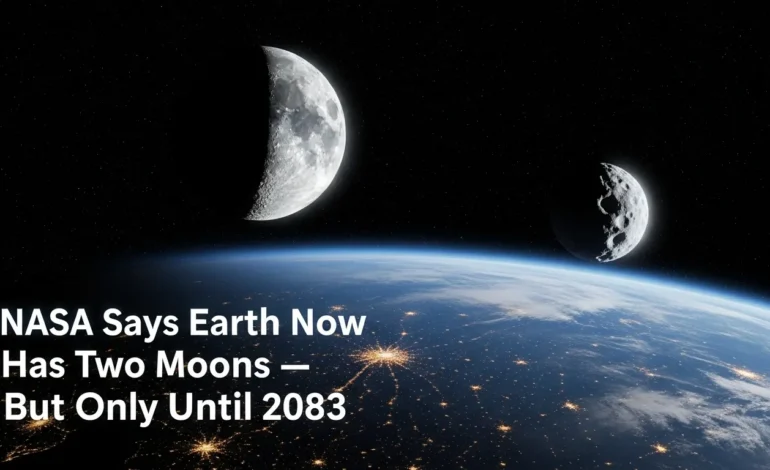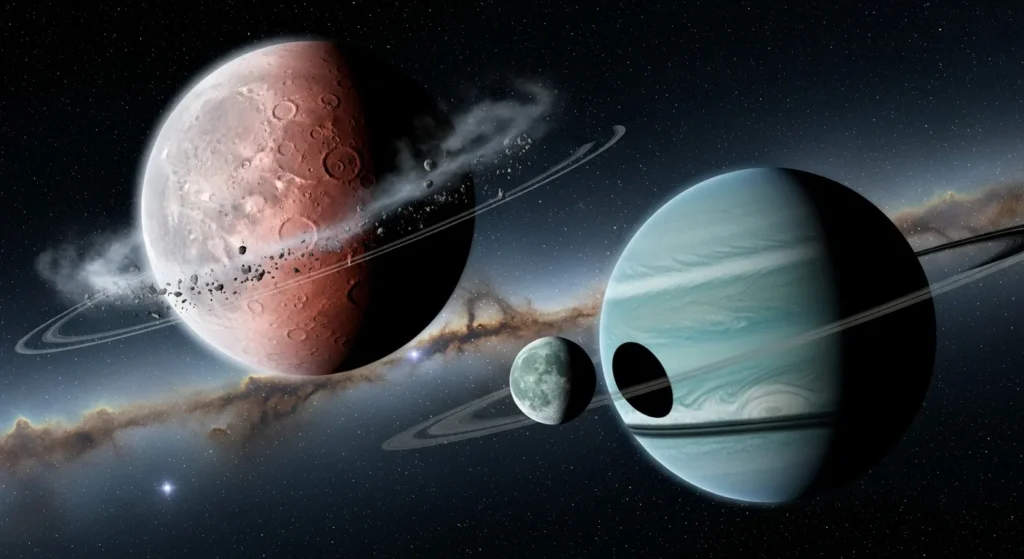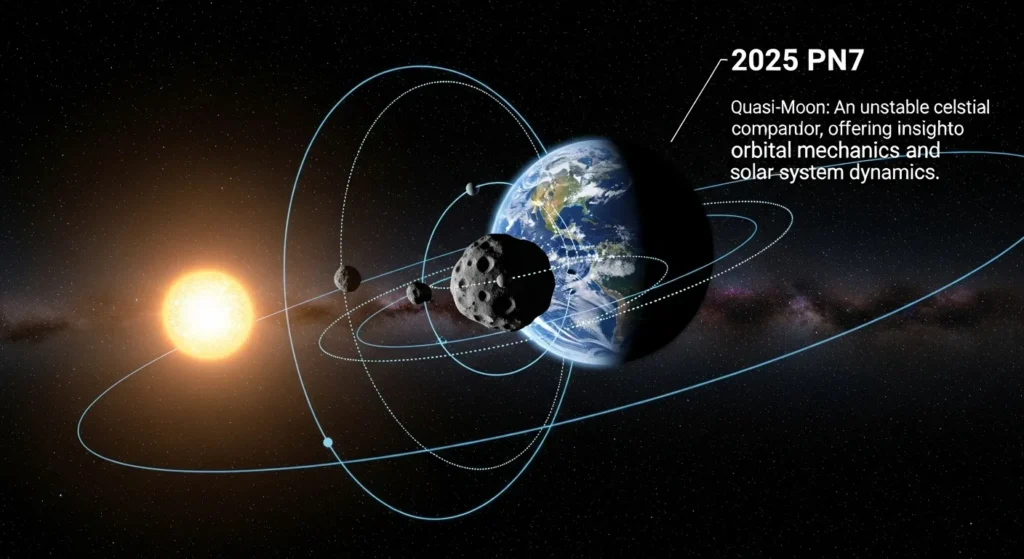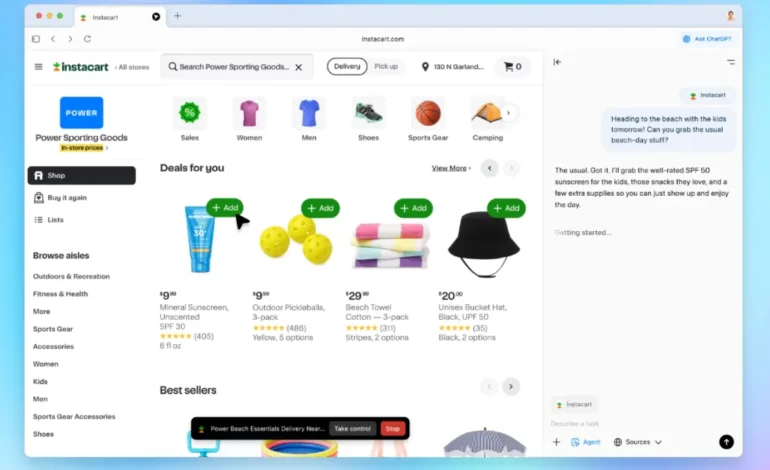NASA Says Earth Now Has Two Moons — But Only Until 2083

Table of Contents
NASA has confirmed an exciting discovery that sounds like science fiction but is real. Earth now has a second moon traveling alongside our planet. This tiny space rock will stay with us until 2083 before drifting away into space.
What Is This Second Moon?
The new companion is called 2025 PN7. NASA identified this small asteroid as a quasi-moon. Unlike our regular Moon, this one does not actually orbit Earth. Instead, it orbits the Sun at almost the same speed as our planet.
Think of it like two runners on a track. They move at the same pace and stay close together. But they are not connected. That is how 2025 PN7 moves through space with Earth.
The asteroid measures between 18 and 36 meters wide. That is about as tall as a small building. Scientists first spotted it in August 2025 using the Pan-STARRS telescope in Hawaii.
How Long Has It Been There?
Here is the surprising part. This quasi-moon has probably been following Earth for about 60 years. Old telescope images show it was there since the 1960s. But nobody noticed it until now.
Why did it take so long to find? The asteroid is extremely small and very dim. Its brightness is magnitude 26, which means it is over 100 million times fainter than stars you can see with your eyes. Only powerful telescopes can spot it.
Understanding Quasi-Moons
A quasi-moon is different from a real moon. Real moons orbit their planet because of gravity. Our Moon has been doing this for 4 billion years.
Quasi-moons orbit the Sun instead. They share the same path around the Sun as a planet. From Earth, they look like they are circling us. But the Sun’s gravity controls them more than Earth does.
These space rocks are not stable. After some time, they drift away. Some come back later in different orbits.

Where Did 2025 PN7 Come From?
This asteroid comes from the Arjuna asteroid belt. This belt contains space rocks that follow orbits very similar to Earth‘s path. These asteroids stay about 93 million miles from the Sun.
Objects in the Arjuna belt can approach Earth at close range. They move at relatively slow speeds of less than 2,200 miles per hour. This allows Earth‘s gravity to influence them slightly.
Scientists do not know the exact origin of 2025 PN7. It might be a piece from a larger asteroid. Some quasi-moons even come from our own Moon after meteorite impacts.
How Close Does It Get?
Do not expect to see two moons in the night sky. The quasi-moon stays very far from Earth.
At its closest, 2025 PN7 comes within 4 million kilometers. That is about 10 times farther than our regular Moon. Sometimes it moves as far as 17 million kilometers away.
The distance keeps changing because its orbit is slightly different from Earth‘s. Gravity from the Sun and other planets pulls on it.
Is It Dangerous?
No need to worry. This second moon poses zero threat to our planet.
NASA confirms that 2025 PN7 never comes close enough to hit us. It stays millions of kilometers away at all times. The asteroid has no effect on Earth‘s tides or gravity. Your daily life will not change at all.
Its orbit appears stable for now. Small factors like sunlight pressure could shift its path over time. But scientists say it will not become dangerous.
Can You See It?
Unfortunately, you cannot spot this quasi-moon with your eyes. Even binoculars and amateur telescopes are not strong enough.
Professional telescopes can detect it. You need a telescope at least 30 inches wide with special cameras. The asteroid is too small and too dim for regular equipment.
Scientists will capture images of it. You can watch for these photos online from observatories.
When Will It Leave?
NASA predicts that 2025 PN7 will stay near Earth until around 2083. That gives us about 60 more years with this cosmic companion.
After 2083, the Sun’s gravity will pull it away. It might switch to a different type of orbit. Some asteroids like this return later in new patterns.
Other Quasi-Moons
Earth has had other quasi-moons before. Scientists have found at least seven other quasi-moons traveling near our planet.
One famous example is called Kamo’oalewa. This quasi-moon appears to be made of Moon rock. It might have been blasted off the Moon by an asteroid impact long ago.
Another asteroid called 2024 PT5 became a temporary mini-moon. It orbited Earth from September to November 2024. That one only stayed for 57 days.
Mini-moons are slightly different from quasi-moons. Mini-moons actually orbit Earth for a short time. They complete at least one full circle around our planet.
Why This Matters for Science
Scientists are excited about 2025 PN7 for several reasons.
Quasi-moons help astronomers understand orbital mechanics. They show how gravity from different bodies affects small space rocks. This teaches us about how objects move through the solar system.
Tracking quasi-moons also helps with planetary defense. Even though this one is safe, studying it improves tools for spotting dangerous asteroids. Better tracking systems can protect Earth from real threats.
Quasi-satellites might be good targets for space missions. They stay near Earth for long periods. Sending a spacecraft to one would cost less than chasing distant asteroids. China already launched a probe to visit a quasi-moon in May.
These asteroids might also tell us about Earth‘s formation. They contain primitive material from when the solar system was born. Studying them could reveal what building blocks made our planet.

How Pan-STARRS Found It
The Pan-STARRS telescope system made this discovery possible. Pan-STARRS stands for Panoramic Survey Telescope and Rapid Response System.
This powerful telescope sits atop Haleakala volcano in Hawaii. It uses one of the largest digital cameras ever built. Each camera has about 1.4 billion pixels.
Pan-STARRS scans huge areas of sky every night. It takes about 500 images each night. This helps find moving objects and changes in the sky.
The telescope was funded by the U.S. Air Force. NASA also provides funding for its asteroid-hunting mission. Pan-STARRS has discovered many important objects, including the first interstellar visitor.
Social Media Buzz
News about Earth‘s second moon spread quickly on social media platforms. People on Instagram and Facebook shared the discovery. Many were amazed to learn about this hidden companion.
Some Reddit users discussed how quasi-moons work. Amateur astronomers explained the difference between real moons and quasi-satellites. The conversations showed public interest in space discoveries.
Looking Ahead
The discovery of 2025 PN7 reminds us that space still holds surprises. Even near Earth, we continue finding new objects. This quasi-moon traveled with us for 60 years before anyone noticed.
NASA and other space agencies will keep watching 2025 PN7. They want to learn more about its composition and behavior. Future missions might even visit it up close.
For now, this tiny companion will quietly travel alongside Earth through space. Most people will never see it with their eyes. But knowing it is there adds to the wonder of our cosmic neighborhood.
Earth is not alone on its journey around the Sun. We have silent travelers keeping us company, even if only for a little while.
Did you find this article helpful? Check out the rest of our site for more great content!
Frequently Asked Questions
Does Earth really have two moons now?
Not exactly. Earth has one real moon and one quasi-moon. The quasi-moon does not actually orbit Earth. It orbits the Sun in a path similar to our planet.
Will we see two moons in the sky?
No. The quasi-moon is too small and dim to see. It will not change how the night sky looks.
Is the second moon dangerous?
Not at all. NASA confirms it poses no threat. The asteroid stays millions of kilometers away. It has no effect on tides or daily life.

